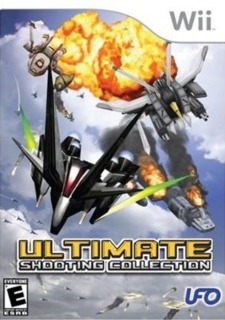Three unique scrolling shoot em ups from the Sega Naomi arcade board that shouldn't be missed by fans of the genre.
The earliest game in the collection is Chaos Field, originally developed for the Arcade and Dreamcast in 2004 and ported to the Gamecube in 2005. Titled for a duality mechanic in the game, it focuses on a continual series of boss fights. You can switch between two "fields" in the game, the chaos field and the order field. In the order field the enemies are weaker and power-ups frequent, and in the chaos field the enemies are tougher, but their bullets can be targeted with your lock-on feature enabling you to achieve higher scores through combos. Their are three ships to choose from, each with strengths and weaknesses, as well a short range sword swipe unique to that ship used to clear the area around your ship of certain types of enemy bullets. Its presentation is the most standard of the three shooters and the designs of the ships and enemies are a little pedestrian, although it does have nice effects and a strong colorful palette.
Radirgy (Radio Allergy) is notable for its odd cel-shaded graphics and its even odder quirky anime story, but behind its light-hearted nature are a lot of nifty mechanics that make for a solid shooter. It was made for the Naomi Arcade board in 2005 and ported to the DC, PS2, and GC in 2006. Again boasting three designs (mecha instead of ships this time) to pick from, each have a different main weapon, those being the wide shot, the bubble shot, or lasers and each can be customized with three speed settings. Again it has a short range sword mechanic, although this time the sword has an additional ability to juggle power-ups allowing you change what they do, from refilling your shield gauge to powering up your main weapon, for instance. The game encourages you to use your sword in spite of the danger that implies by giving better shield refilling rewards and by giving you bonuses to your shield gauge for close call shavings with enemies, and refilling that shield is usually top priority. The reason for this is that when engaged, the shield makes you invulnerable while still being able to attack and further replenish the shield. The enemies within the shield produce multiplier bonuses, so you have to constantly choose between score (leaving enemies in the shield alive to keep producing bonuses) and safety (killing the enemies in the shield to keep the shield going). It's easy to dismiss this game, its cel-shaded graphics look dated (though I think charming, if a little bland, but that makes it easier to make everything out) and its a bit talky and the designs again are not that inspired, but its mechanics are uncommonly distinctive for a shoot em up.
The final game in the collection is Karous (Crow), made for the Naomi board in 2006 and ported to the Japanese Dreamcast as its final official release in 2007. If you like many of the mechanics and the feel of Radirgy, but wanted a more minimalist, less quirky colorful anime style, then Karous is the answer. Its not as elegant as it should be (better enemy designs would have went a long way toward helping here), but it has a nice drum n bass soundtrack, a few splashes of color here and there in an otherwise muted and grey cel-shaded palette, both of which set a bleak, moody vibe. You again have a sword for bullet cancelling; it retains the ability to juggle power ups to select the one you want and again the sword is the main weapon for higher scores. You also have a frontal cone shield and a wide shot, but the shield acts as a bullet cancelling weapon and can only be used when not using another weapon. There is a gauge similar to the Radirgy shield system, but this time it is offensive in nature, with enemies blowing up while inside your barrier. Freshness is provided by the leveling system, which allows you to upgrade your weapons & shield through experience. The level of your weapons acts as a score multiplier and at various levels your weapons receive pretty dramatic upgrades, and since you choose which of the three weapons (shield, shot, or sword) receive experience through use, you can customize the game to a more offensive or defensive affair.
This collection may not be the "Ultimate" shoot em up fans dream, or anything of the sort, but it does represent three solid examples of where the genre stands in the last couple of years, at least from the point of view of one of the few companies still making these sorts of games.

